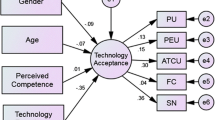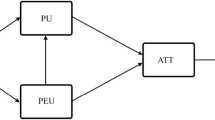Abstract
This study uses the Technology Acceptance Model (TAM) to explore the factors that impact special education teachers’ acceptance and actual use of technology. TAM is used as the foundation for generating the hypothesis and developing the conceptual framework for the study. Twenty-four (n=24) special education teachers in a private school in the United Arab Emirates (UAE) participated in this study by answering an electronic questionnaire that included items related to Perceived Usefulness, Perceived Ease of Use, Attitudes Towards Usage, Behavioural Intention to Use, Access to Technology, Job Relevance, Self-Efficacy, Time, and Actual Usage. Preliminary findings indicate that special education teachers have positive attitudes towards the use of technology. Self-efficacy, time and access to technology were found to significantly impact actual use of technology. The research results provide initial insights on special education teachers attitudes towards using technology in their practice as well as the factors that may facilitate or hinder their actual use. Implications for practice and future research are discussed.



Similar content being viewed by others
References
Alharbi, S., & Drew, S. (2014). Using the technology acceptance model in understanding academics’ behavioural intention to use learning management systems. International Journal of Advanced Computer Science and Applications, 5(1), 143–155.
Almeida, C. M., Jameson, J. M., Riesen, T., & McDonnell, J. (2016). Urban and rural preservice special education teachers' computer use and perceptions of self-efficacy. Rural Special Education Quarterly, 35(3), 12–19.
Alshammari, S. H., Ali, M. B., & Rosli, M. S. (2016). The Influences of Technical Support, Self-Efficacy and Instructional Design on the Usage and Acceptance of LMS: A Comprehensive Review. Turkish Online Journal of Educational Technology-TOJET, 15(2), 116–125.
Baglama, B., Yikmis, A., & Demirok, M. S. (2017). Special education teachers’ views on using technology in teaching mathematics. European Journal of Special Education Research.
Bagozzi, R. P. (2007). The legacy of the technology acceptance model and a proposal for a paradigm shift. Journal of the association for information systems, 8(4), 3.
Bahr, D. L., Shaha, S. H., Farnsworth, B. J., Lewis, V. K., & Benson, L. F. (2004). Preparing Tomorrow's Teachers to Use Technology: Attitudinal Impacts of Technology-supported Field Experience On Pre-service Teacher Candidates. Journal of Instructional Psychology, 31(2).
Bandura, A. (1977). Self-efficacy: toward a unifying theory of behavioral change. Psychological review, 84(2), 191.
Baturay, M. H., Gökçearslan, Ş., & Ke, F. (2017). The relationship among pre-service teachers' computer competence, attitude towards computer-assisted education, and intention of technology acceptance. International Journal of Technology Enhanced Learning, 9(1), 1–13.
Benbasat, I., & Barki, H. (2007). Quo vadis TAM? Journal of the Association for Information Systems, 8(4), 7.
Birkollu, S. S., Yucesoy, Y., Baglama, B., & Kanbul, S. (2017). Investigating the Attitudes of Preservice Teachers Towards Technology Based on Various Variables. TEM Journal, 6(3), 578–583.
Bruhn, A. L., Woods-Groves, S., Fernando, J., Choi, T., & Troughton, L. (2017). Evaluating technology-based self-monitoring as a tier 2 intervention across middle school settings. Behavioral Disorders, 42(3), 119–131.
Buabeng-Andoh, C. (2012). Factors influencing teachers' adoption and integration of information and communication technology into teaching: A review of the literature. International Journal of Education and Development using Information and Communication Technology, 8(1), 136.
Cafiero, J. M. (2012). Technology supports for individuals with autism spectrum disorders. Journal of Special Education Technology, 27(1), 64–76.
Chang, J. L., Lieu, P. T., Liang, J. H., Liu, H. T., & Wong, S. L. (2011). Factors influencing technology acceptance decisions. African Journal of Business Management, 5(7), 2901–2909.
Cheon, J., Lee, S., Crooks, S. M., & Song, J. (2012). An investigation of mobile learning readiness in higher education based on the theory of planned behavior. Computers & Education, 59(3), 1054–1064.
Conti, D., Commodari, E., & Buono, S. (2017). Personality factors and acceptability of socially assistive robotics in teachers with and without specialized training for children with disability. Life Span and Disability, 20(2), 251–272.
Creswell, J. W. (2014). Educational Research: Planning, Conducting, and Evaluating Quantitative and Qualitative Research. Pearson publications.
Crutchfield, S. A., Mason, R. A., Chambers, A., Wills, H. P., & Mason, B. A. (2015). Use of a self-monitoring application to reduce stereotypic behavior in adolescents with autism: A preliminary investigation of I-Connect. Journal of Autism and Developmental Disorders, 45(5), 1146–1155.
Davis, F. D. (1989). Perceived usefulness, perceived ease of use and user acceptance of information technology. MIS Quarterly, 13(3), 319–339.
El Alfy, S., Gómez, J. M., & Ivanov, D. (2017). Exploring instructors’ technology readiness, attitudes and behavioral intentions towards e-learning technologies in Egypt and United Arab Emirates. Education and Information Technologies, 22(5), 2605–2627.
Elkaseh, A. M., Wong, K. W., & Fung, C. C. (2016). Perceived ease of use and perceived usefulness of social media for e-learning in Libyan higher education: a structural equation modeling analysis. International Journal of Information and Education Technology, 6(3), 192.
Fullan, M. (2001). The new meaning of educational change (3rd ed.). New York: Teachers College Press.
Gorsuch, R. L. (1988). Exploratory factor analysis. In Handbook of multivariate experimental psychology (pp. 231–258). Boston: Springer.
Guieford, J. P. (1965). Fundamental Statistics in Psychology and Education. New York: McGram-Hill.
Holden, H., & Rada, R. (2011). Understanding the influence of perceived usability and technology self-efficacy on teachers’ technology acceptance. Journal of Research on Technology in Education, 43(4), 343–367.
Ismail, S. A. A., Almekhlafi, A. G., & Al-Mekhlafy, M. H. (2010). Teachers’ perceptions of the use of technology in teaching languages in United Arab Emirates’ schools. International Journal for Research in Education, 27(1), 37–56.
Juhary, J. (2014). Perceived usefulness and ease of use of the learning management system as a learning tool. International Education Studies, 7(8), 23.
Ke, F., & Moon, J. (2018). Virtual collaborative gaming as social skills training for high-functioning autistic children. British Journal of Educational Technology, 49(4), 728–741.
Kopcha, T. J. (2012). Teachers' perceptions of the barriers to technology integration and practices with technology under situated professional development. Computers & Education, 59(4), 1109–1121.
Koutromanos, G., Styliaras, G., & Christodoulou, S. (2015). Student and in-service teachers’ acceptance of spatial hypermedia in their teaching: The case of HyperSea. Education and Information Technologies, 20(3), 559–578.
Leong, L. W., Ibrahim, O., Dalvi-Esfahani, M., Shahbazi, H., & Nilashi, M. (2018). The moderating effect of experience on the intention to adopt mobile social network sites for pedagogical purposes: An extension of the technology acceptance model. Education and Information Technologies, 23(6), 2477–2498.
Litz, D., & Scott, S. (2017). Transformational leadership in the educational system of the United Arab Emirates. Educational Management Administration & Leadership, 45(4), 566–587.
Liu, S. H. (2012). A multivariate model of factors influencing technology use by preservice teachers during practice teaching. Journal of Educational Technology & Society, 15(4), 137.
Masrom, M. (2007). Technology acceptance model and e-learning. Technology, 21(24), 81.
Mathieson, K., Peacock, E., & Chin, W. W. (2001). Extending the technology acceptance model: the influence of perceived user resources. ACM SIGMIS Database: the DATABASE for Advances in Information Systems, 32(3), 86–112.
Narkon, D. E., Wells, J. C., & Segal, L. S. (2011). E-word wall: An interactive vocabulary instruction tool for students with learning disabilities and autism spectrum disorders. Teaching Exceptional Children, 43(4), 38–45.
O’Malley, P., Lewis, M. E. B., Donehower, C., & Stone, D. (2014). Effectiveness of using iPads to increase academic task completion by students with autism. Universal Journal of Educational Research, 2(1), 90–97.
Okolo, C. M., & Diedrich, J. (2014). Twenty-five years later: How is technology used in the education of students with disabilities? Results of a statewide study. Journal of Special Education Technology, 29(1), 1–20.
Oye, N. D., Iahad, N. A., & Rahim, N. A. (2014). The history of UTAUT model and its impact on ICT acceptance and usage by academicians. Education and Information Technologies, 19(1), 251–270.
Parkman, S., Litz, D., & Gromik, N. (2018). Examining pre-service teachers’ acceptance of technology-rich learning environments: A UAE case study. Education and Information Technologies, 23(3), 1253–1275.
Saddler, B., Newman, D., & Passa, K. (2006, March). The Benefits of Integrating Technology Into Inclusive Classrooms. In Society for Information Technology & Teacher Education International Conference (pp. 4225–4230). Association for the Advancement of Computing in Education (AACE).
Sahin, A., Top, N., & Delen, E. (2016). Teachers’ first-year experience with chromebook laptops and their attitudes towards technology integration. Technology, Knowledge and Learning, 21(3), 361–378.
Schmidt, M. M. (2014). Designing for learning in a three-dimensional virtual learning environment: A design-based research approach. Journal of Special Education Technology, 29(4), 59–71.
Siegel, J., Good, K., & Moore, J. (1996). Integrating technology into educating preservice special education teachers. Action in Teacher Education, 17(4), 53–63.
Siyam N. (2018, in press). Special Education Teachers’ Perceptions on Using Technology for Communication Practices. Journal for Researching Education Practice and Theory (JREPT), 1(2), 1–16.
Stockless, A. (2018). Acceptance of learning management system: The case of secondary school teachers. Education and Information Technologies, 23(3), 1101–1121.
Teo, T. (2008). Pre-service teachers' attitudes towards computer use: A Singapore survey. Australasian Journal of Educational Technology, 24(4).
Teo, T. (2009). Examining the Relationship between Student Teachers' Self-Efficacy Beliefs and Their Intended Uses of Technology for Teaching: A Structural Equation Modelling Approach. Turkish Online Journal of Educational Technology-TOJET, 8(4), 7–15.
Teo, T. (2011a). Factors influencing teachers’ intention to use technology: Model development and test. Computers & Education, 57(4), 2432–2440.
Teo, T. (Ed.). (2011b). Technology acceptance in education. Springer Science & Business Media.
Teo, T., Faruk Ursavaş, Ö., & Bahçekapili, E. (2011). Efficiency of the technology acceptance model to explain pre-service teachers' intention to use technology: A Turkish study. Campus-Wide Information Systems, 28(2), 93–101.
Tyler-Wood, T. L., Putney, D., & Cass, M. A. (1997). Accessibility: the main factor influencing special education teachers’ perceived level of computer competence. Journal of Computing in Teacher Education, 13(4), 20–24.
Venkatesh, V., & Davis, F. D. (2000). A theoretical extension of the technology acceptance model: Four longitudinal field studies. Management science, 46(2), 186–204.
Wu, C., & Liu, C. F. (2015). Acceptance of ICT-mediated teaching/learning systems for elementary school teachers: Moderating effect of cognitive styles. Education and Information Technologies, 20(2), 381–401.
Xin, Y. P., Tzur, R., Hord, C., Liu, J., Park, J. Y., & Si, L. (2017). An intelligent tutor-assisted mathematics intervention program for students with learning difficulties. Learning Disability Quarterly, 40(1), 4–16.
Zhao, Y., Tan, S. H., & Mishra, P. (2001). Teaching and learning: Whose computer is it? Journal of Adolescent & Adult Literacy, 44(4), 348.
Author information
Authors and Affiliations
Corresponding author
Additional information
Publisher’s Note
Springer Nature remains neutral with regard to jurisdictional claims in published maps and institutional affiliations.
Rights and permissions
About this article
Cite this article
Siyam, N. Factors impacting special education teachers’ acceptance and actual use of technology. Educ Inf Technol 24, 2035–2057 (2019). https://doi.org/10.1007/s10639-018-09859-y
Received:
Accepted:
Published:
Issue Date:
DOI: https://doi.org/10.1007/s10639-018-09859-y




